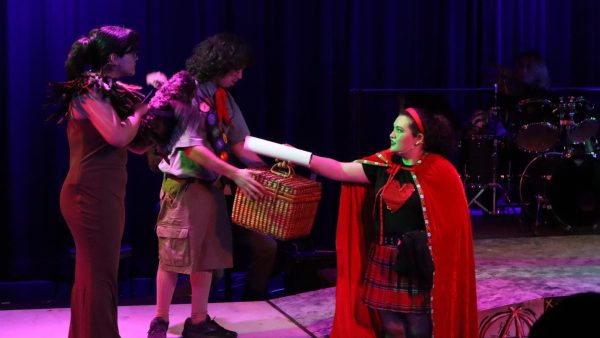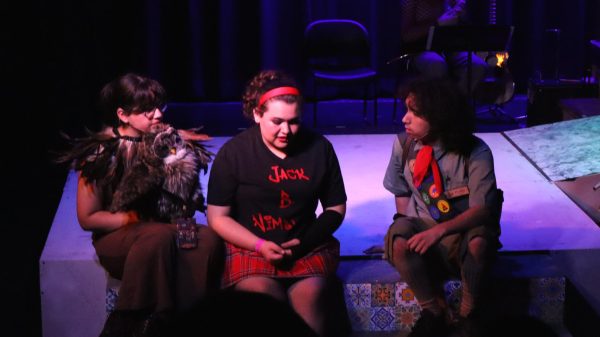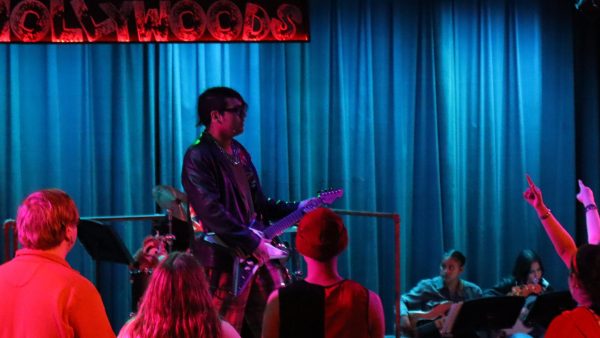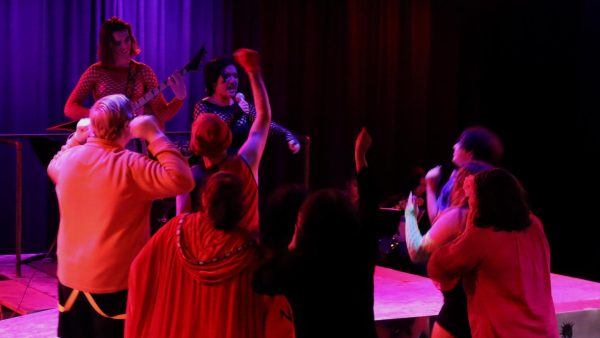The MSJC Theater debuted Little Red, the musical directed by Melanie Queponds, from Oct. 26 – Oct. 29. Written by Anthony Aguilar, Oscar Basulto, and Quetzal Flores, Little Red is a musical retelling of the fairytale Little Red Riding Hood with a twist of punk-rock influenced musical numbers, several horror elements, spry with comedy, and nonetheless witty. It is also pure in its commentary on what constitutes rebellion and blind rage, and the significance of family culture and tradition, with enumerate qualities in between that both embrace and dispel Red’s iconoclastic fantasy world.
Set in its own parodied version of Los Angeles and Hollywood (the Hollywoods), Little Red tells the story of Red (Aryana Campos) who must embrace a time-honored tradition of carrying a basket with her grandmother’s “health and welfare.” Red, a hesitant and rebellious youth influenced by the punk scene, is reluctant to obey or see the importance of this tradition. Instead, she prefers the audacious path: to rock out, rebel, and see punk shows. Additionally, we have a story intertwined with folk tales, the conflict of the generational shifts in honoring cultural tradition, the heavy-laden numbers of punk music, and fervent comedy embedded in memorable characters.

The story begins with Red and her sister, Scarlet (Maria Escobedo), as youths enchanted by the milieu of the punk scene, reminiscent of the 70s and 80s. Red especially, is spurred with a passion for the anti-authority sentiments beget by the music against her family traditions. “These are the bands that speak to me, this is the music that sets me free!” she exclaims in the second musical number: “Día del Sendero,” in a record store about bands such as The Clash, Black Flag, The Stooges, Pixies, Joy Division, Ramones, and the musical’s original, and her favorite, The Jack B. Nimbles. Owing to the band’s onstage background company throughout, the audience is attacked with an atmosphere not unlike that of a small concert.

With the fixation on seeing her favorite band live, the irreverent youthful angst and rebellion of Red are counteracted when her mother designates that she take up the tradition of Día del Sendero (Day of the Journey), a cultural and familial practice where the daughter who turns sixteen must take a basket to her grandmother, her Abuela (here, Mel Figueroa). The reluctant Red, forced into this situation, is adamant about not obeying. She despises this chore in a rather magnificent way. As her sister has gone to college and Red is left with the task, she is reminded of the looming—nearly haunting—memory of Scarlet that shadows her for the duration of the play. In a way, this memory of Scarlet is central, and the undertone of introspective sibling conflict leaves its important mark. “She was the perfect daughter,” says her mother, in a moment that takes place inside Red’s head.

However, tradition takes its hold over Red and she reluctantly takes up the delivery task. Along her journey, she meets Corky (Jon Queponds), a fervent, peevish, and good-natured boy scout, with his specially trained owl companion and messenger, Paz (Maria Escobedo), who are there to assist Red on her journey and update her mother on her wellbeing; Corky’s family tradition is to assist the Caperucita (in this case, Red) on her journey.
Strayed off course and into the Hollywoods, they meet Don Coyote (Richard Soto), a young English musician who is similar to Red in many ways: rebellious, independent, and angsty, but who embraces much more nefarious actions and is quite morally bankrupt. An abandoned—or abandoning—character, he tempts Red to stay in the Hollywoods forever, so that he might have family. A natural and charismatic trickster, Don deceives Red with fake backstage passes to The Jack B. Nimbles, abandons her, and steals her red hood and basket, seeking to have a place in Abuela’s house.
After Paz takes Red’s backstage pass, the audience sees Red at her most vulnerable, and in the most climactic number yet: “Dear Scarlet,” where she opens up about her plaguing emotions and feelings toward her sister. Overheard by Corky, Red’s true sentiments about her family finally bloom; in a change of heart, she takes up Día del Sendero with pride.

At Abuela’s the characters reconvene and Red provides a number for a change in Don Coyote’s heart, where his cruel nature decomposes before them in a rather pitiable way, but compels him to seek introspection and vulnerability. Arriving at Abuela’s is Red’s mother and Scarlet, reunited, where they all prepare to go see The Jack B. Nimbles in concert—in which the penultimate number unites the family. In the final number, a reprise of the Día del Sendero, the audience sees Red many, many years later departing the tradition to her reluctant daughter.
By the end, we are left with the satisfaction that family has been forever altered but found, and reunited, in the lives of the various characters who had been seeking such closure through other means, and who might now live, in their special way—according to the adage of an old fairytale: happily ever after.
Besides the story, the special effects, provided by technical directors Kristina Jackson and Steven Razo, elicit a sensory-manipulating tone that creeps and crawls about the audience through the masterful work of the musical’s lighting and sound, particularly in scenes where they set a truly horrifying liminal atmosphere. Aesthetic distance is shattered in such instances when the “voices” in Red’s head tell her she is not like her sister or the temptations to stay in the Hollywoods are materialized in a surreal display of a dark and brooding environment with shadowy characters—each of these displays holding their artful and emotional choke on the audience. Moments like these are a surprise but welcome deviation from the ongoing concert-like performance.

Though its elements and style incorporate far more, the fact that Little Red is foremost a musical is not lost on the audience; at points, the audience is entranced by the fact that music is its most consistent quality. Accompanying musical numbers, led by music director Emanuel Esparaza, are backed by a sensational live band (consisting of Elizabeth Javier, Ruby Secules, Karina Reyes-Velazquez, and Angelina Salcedo) who support the performance of memorable, character-driven scenes. When numbers break out, it is usually induced by the character, their state of mind, and the mood they convey. Where the band assists them with great instrumentals, they characterize and give the actor ample time to shine with unique vocal performances. Oftentimes, as with Red, a raucous song and ensemble follow the madness—the case with her “R-E-D in Me” number; with Corky, the lighter more airy sounds fill the theater, reflecting his good-natured character and fixated discipline to assist Red on her journey, as in his two numbers: “Ready for it All” and “The Comfort of Your Home;” in Don Coyote, his impudent nature is radiant in the music with similar madness as Red’s, but much darker and wholly unique on account of his eery, mischievous nature, which looks to sway Red from her path, such as in his “Where You Belong.”

Needless to say, the emotional and angsty sentimentality with the rowdy concert-like atmosphere pervades; the performance of each actor stands memorable; culture and tradition and the generational dynamics are cleverly performed, void of any cliche. The significance of the play is very much its focus on family and the cherishing of family which we have, or accept, and each actor involved stands out in this distinguished musical to convey a wonderful piece, in a thrilling experience.









